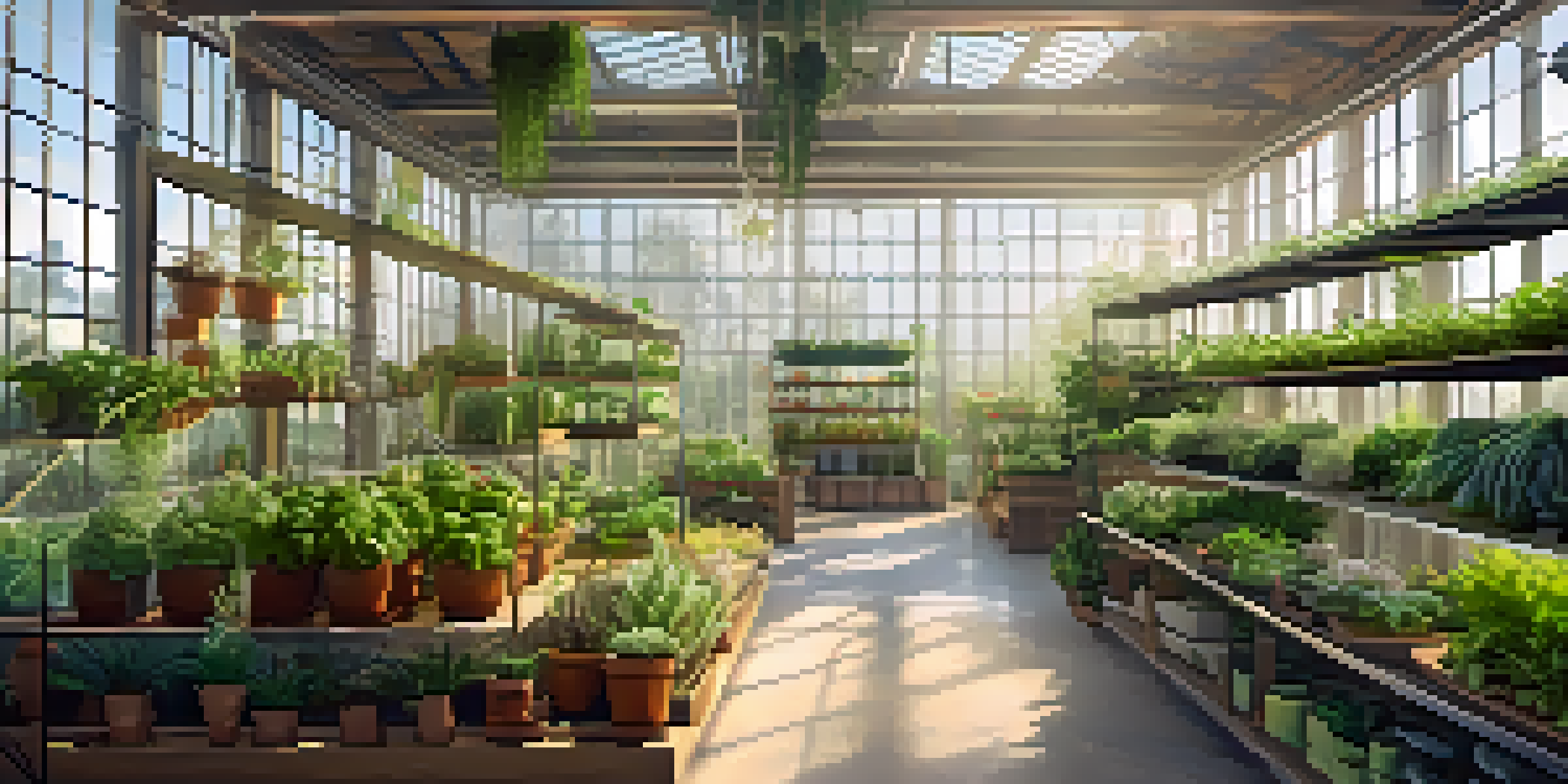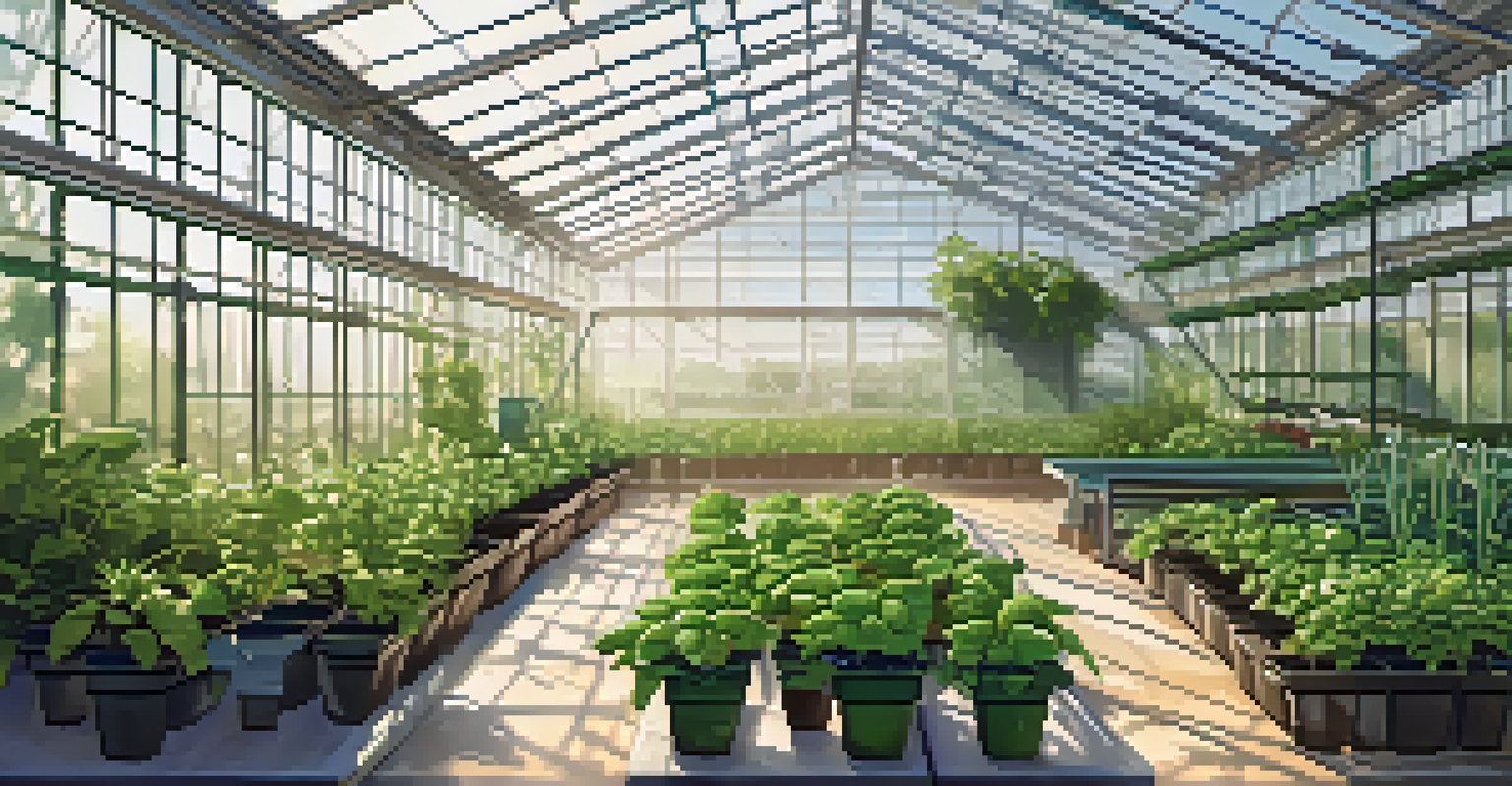How to Maximize Space in Your Greenhouse for Plants

Understand Your Greenhouse Layout for Better Space Management
Before diving into optimizing your greenhouse, take a moment to understand its layout. Visualize how you currently use the space and identify any wasted areas. A well-thought-out layout can significantly enhance plant growth by ensuring each plant receives adequate light and airflow.
The greatest fine art of the future will be the making of a comfortable living from a small piece of land.
Consider creating zones within your greenhouse for different types of plants. For example, grouping herbs together or clustering vegetables can streamline care and maximize efficiency. This approach not only saves space but also allows you to tailor conditions for specific plant needs.
Finally, be sure to leave walkways for easy access to all your plants. A clear path can help you maintain your greenhouse without damaging delicate plants, making it easier to tend to them regularly.
Choose Vertical Gardening Techniques for Space Efficiency
One of the best ways to maximize your greenhouse space is by utilizing vertical gardening techniques. Think of it as stacking your plants upwards rather than spreading them out on the ground. Wall-mounted planters, hanging baskets, and tiered shelves can help you make the most of limited space.

Using vertical space not only increases your planting area but also improves air circulation around your plants. This can lead to healthier plants that are less prone to diseases, as good airflow helps to deter pests and mold.
Optimize Greenhouse Layout
Understanding and organizing your greenhouse layout is essential for maximizing plant growth and ensuring efficient care.
Additionally, consider using trellises for climbing plants like peas and cucumbers. By allowing them to grow vertically, you can free up ground space for other plants in your greenhouse.
Implement Efficient Plant Rotation and Companion Planting
Plant rotation is a strategy that can maximize your greenhouse space by ensuring that your soil remains healthy and productive. Regularly changing the types of plants grown in a specific area prevents nutrient depletion and reduces pest problems. This practice can lead to higher yields and healthier plants over time.
Gardening is a way of showing that you believe in tomorrow.
Companion planting, where you grow different crops close together for mutual benefit, can also make the most of your space. For example, pairing tomatoes with basil can enhance growth while deterring pests naturally.
By combining these two methods, you can create a thriving ecosystem in your greenhouse, enhancing both space and plant health.
Use Layering Techniques for Diverse Plant Growth
Layering is another effective strategy for maximizing greenhouse space. This technique involves planting different species at varying heights, which allows you to utilize every inch of vertical space. For instance, you might grow tall plants like tomatoes alongside shorter herbs such as cilantro.
This not only optimizes space but also creates a microclimate where taller plants can provide shade for those that prefer less direct sunlight. It’s a win-win situation that encourages a diverse and healthy greenhouse environment.
Utilize Vertical Gardening
Implementing vertical gardening techniques can significantly increase planting area while enhancing air circulation for healthier plants.
Remember to consider each plant's light and water requirements when layering. Proper planning ensures that every plant thrives, giving you a bountiful harvest.
Incorporate Mobile Plant Stands for Flexibility
Mobile plant stands are a game-changer when it comes to maximizing space in your greenhouse. These stands allow you to easily rearrange plants based on their sunlight needs and growth stages. This flexibility is particularly useful during the changing seasons when light conditions can vary significantly.
Imagine having different levels where you can adjust the height of your plants. This not only enhances light exposure but also creates an organized and visually appealing greenhouse. Plus, it makes caring for your plants much more convenient.
When choosing mobile stands, look for sturdy options that can support the weight of your plants while being easy to move. This way, you can create the perfect conditions for all your greenhouse inhabitants.
Optimize Lighting for Healthy Plant Growth
Proper lighting is crucial for maximizing your greenhouse space. Plants need light to photosynthesize and grow, so ensuring they receive adequate light is essential. If you're in a particularly shady area, consider adding supplemental grow lights to boost natural sunlight.
Positioning your plants based on their light needs can also help maximize space. For example, placing light-loving plants at the top and shade-tolerant ones below can create an efficient lighting system that benefits all.
Implement Regular Maintenance
Consistent maintenance helps keep your greenhouse organized and encourages a thriving environment for your plants.
Regularly monitor your plants to see how they respond to light conditions. Adjust their positions as needed to ensure optimal growth and space utilization.
Utilize Efficient Watering Systems for Better Space Use
An efficient watering system can significantly impact how you utilize space in your greenhouse. Instead of hand-watering each plant, consider drip irrigation or self-watering systems. These methods not only save time but also ensure that plants receive consistent moisture without overcrowding.
With a well-designed watering system, you can place plants closer together, knowing that each will still receive adequate water. This can free up space for additional plants or allow for better airflow, reducing the risk of disease.

Be sure to regularly check your watering systems for clogs or leaks. Keeping everything running smoothly ensures that your greenhouse remains a productive environment.
Regular Maintenance: Keep Your Greenhouse Organized
Regular maintenance is key to maximizing space in your greenhouse. Take time to prune plants, remove dead leaves, and organize tools to maintain a tidy environment. A clutter-free greenhouse not only looks better but also allows for easier access to plants and tools.
Consider scheduling routine checks to assess plant health and space utilization. This proactive approach helps you identify any overcrowding or potential issues before they become major problems.
By making maintenance a priority, you can ensure your greenhouse remains an efficient and inviting space for your plants to thrive.